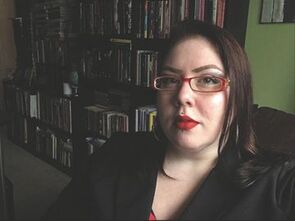| Roy Edward Jackson was a teacher and librarian with the Atlanta Public Schools for over twenty years. Currently, he is a graduate student and teacher with the Northeast Ohio Master of Fine Arts program at Youngstown State University studying creative writing. Erinn Bentley is a professor of English education at Columbus State University in Georgia and the co-editor of Teaching/Writing: The Journal of Writing Teacher Education. |
There is an ever pervasive misnomer that LGTBQ books are about sex, and not about identity. While some YA LGTBQ books, just like YA straight books, do contain an appropriate sexual exploration content, most titles center the story around identity and not any sexual act. But the muddling of identity and sexual acts by those who challenge these books is concerning as it may lead to erasing representation. Young readers need to not only see themselves represented in books, but all young readers need to read about people different from themselves to foster acceptance and understanding.
While the continued increase in YA LGTBQ published titles yearly is encouraging, there is a nuance that needs to be considered. Roughly 50% of all YA LGTBQ published books are centered around white, cis gendered, gay males. That number is concerning as the majority of YA LGTBQ titles seem to solely focus on one letter in the acronym of the community, along with one race.
YA books published with a lesbian protagonist only account for approximately 25% of all YA LGTBQ titles. It begs the question; why the lack of diversity in race and gender in YA LGTBQ publishing? This could be attributed to the fact that the publishing industry workforce is comprised of almost 75% white, straight, cis gendered females. While this workforce may have led to a disproportionate focus on one letter of the LGTBQ community there is something to celebrate. In the last few years, a growing number of books that have a lesbian protagonist have not only included a much needed diversity in gender and race, but they have also transcended genre as well. In today’s post, we have focused on 6 noteworthy titles.
Regarding LGBTQ representation, the five main characters identify as bisexual, lesbian, gay, pansexual, and demisexual. What is endearing about this novel is that it does not focus on a romantic relationship. Instead, it centers on a friendship between a boy and a girl who do not fall in love, but share a powerful connection. Regarding diversity, the characters are mixed race, White, and Korean. This may be one of the most diverse casts of characters in contemporary YA literature.
Girls Made of Snow and Glass by Melissa Bashardoust is a feminist re-telling of “Snow White.” Set in a dark, fairy-tale world, the novel is told from the alternating perspectives of Princess Lynet (Snow White) and Mina (Lynet’s stepmother). Mina’s heart is replaced with glass, making her wonder if she is capable of feeling love. Princess Lynet is made from snow, making her wonder if she can feel human. Enter missionary.lds.org/clothing Nadia, the young court surgeon, whose friendship with Lynet evolves into a romantic relationship. Some familiar plot points are woven together with fresh twists. Ultimately, this is not a tale, but a portrayal of strong women who refute their fates and save themselves and one another.
For anyone tired of damsels in distress, this novel is refreshing. For any girl who has been told her worth lies in her physical appearance or in being “delicate,” these characters are empowering. Regarding LGBTQ representation, the romance between Lynet and Nadia, though sweet, plays a minor role. Instead, the novel predominantly focuses on family relationships, whether those families are forged in blood, through magic, or are found.
| Girl Mans Up by M.E. Girard portrays Pen, a lesbian teen in contemporary Canada. At home and at school, she is ridiculed for not looking or acting “like a girl.” Pen’s parents, who immigrated from Portugal, complicate her situation, as they hold traditional views of gender roles and constantly criticize her. Pen’s life changes when she becomes close with two classmates - Blake (her girlfriend) and Olivia (a platonic friend). Torn between her new relationships and loyalty to lifelong friends (who have been abusive), Pen bravely and fiercely fights to be understood, respected, and - ultimately - loved. Regarding “L” representation, this novel squarely centers on a queer relationship and the struggles this teen faces due to her sexual orientation and presentation. Additionally, Pen is a first-generation immigrant. While Pen does experience some triumphs, much of the novel includes visceral descriptions of the verbal, emotional, psychological, and physical abuse she endures. It is by no means an easy read, but the characters are so real and raw, it is well worth spending time in their world. |














 RSS Feed
RSS Feed